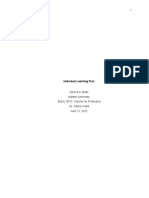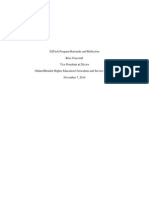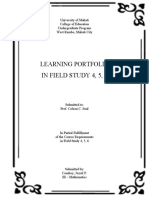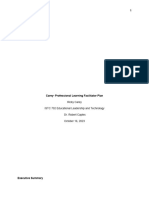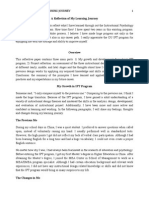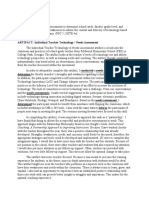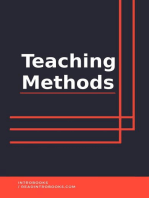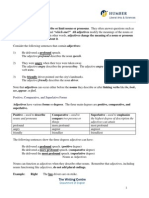Portfolio-Professional Statement and Goals
Portfolio-Professional Statement and Goals
Uploaded by
api-235551194Original Title
Copyright
Available Formats
Share this document
Did you find this document useful?
Is this content inappropriate?
Report this DocumentCopyright:
Available Formats
Portfolio-Professional Statement and Goals
Portfolio-Professional Statement and Goals
Uploaded by
api-235551194Copyright:
Available Formats
Professional Statement and Goals
MSEd in Instructional Technology Professional Portfolio- Personal Reflection and Goals Statement Lynnea Urbanowicz Northern Illinois University
Professional Statement and Goals Goals Statement
My goal is to be a leader in the field of instructional technology through the consistent and effective utilization of technology with my students on a daily basis to impact student achievement, motivation, and engagement.
Personal Statement Initially, entering a MSEd program in Instructional Media and Technology, I truly was unsure of the learning that would soon follow and I am beyond grateful for this opportunity to enhance my personal and professional growth as an IT professional. My undergraduate program at Wheaton College, as well as professional development opportunities within education have helped shape my readiness to interact with this course as well as prepared me to work well in a group environment and take individual responsibility for learning. The content covered has truly helped shape me as an educator and increased my knowledge of best practice as I am able to reflect upon my own teaching and design practices within the classroom and refocus my lens on instruction and incorporating technology in the classroom. I am extremely passionate about technology and education design and I am constantly learning and trying to incorporate innovative ways to increase student motivation, engagement, and achievement. Technology is an avenue that I believe can accomplish this goal. The content covered throughout this program has truly been an eyeopening experience as I am able to reflect upon my own teaching and design practices within the classroom and refocus my lens on instruction and
Professional Statement and Goals incorporating technology in the classroom, while finding deeper ways of approaching the instructional design process and technology implementation. This is an area that I feel extremely passionate about and I am constantly learning and trying to incorporate new things in my fifth grade classroom
environment. Our very nature of schooling and the students that are being taught are changing the way instruction is being planned and implemented; it excites me to be an innovator in the 21st century and find new ways to challenge my thinking and improve upon my instructional practices. I think the most beneficial way we can learn is by doing. We had many opportunities throughout this cohort to put our reading knowledge into practice and I appreciated having opportunities to continually collaborate with my peers to enhance and further my own learning. Additionally, this program has opened the door for more reflection on my own instructional design practices and being explicitly intentional with my planning and improving. Because of the information gained during this program, I dont think I will ever be the same instructor because I am already noticing how my planning has blossomed and my use of higher order questioning and objective writing has grown. When learning about the knowledge building principles it struck me that improvement on design helps students share knowledge and tackle projects that incorporate features of adult teamwork, realworld content, and use of varied information sources (Scardamalia & Bereiter, 2007). Students are more engaged in the learning process when the learning is directed and driven by the interest of the students.
Professional Statement and Goals Instructional design is the process of purposefully planning learning activity or experience to achieve desired results and meet learning goals. There are a variety of ID models that can be utilized when planning for instruction, but at the heart of each are the components of analysis, design, development, implementation, and evaluation. Educators need to keep this entire process in mind when planning for instruction and constantly evaluate the learning that is taking place in the classroom. The paradigm shift from a traditional approach, where the focus of learning was placed heavily on the learner has fortunately swung into proper perspective. The learning process has as much to do with the process itself and design plan as it does on the learners and instructors. Attention to learners perspectives, preferences, and ownership of the learning process has grown. These shifts have changed the field from one where design of instruction as mainly delivered, to a field seeking to create learning environments in which learners can explore and are provided with opportunities for practical application in order to arrive at meaningful understanding are
present (AECT, 1997). This environment for ID should involve active participation of the learner and construct unique learning paths where the knowledge can be applied in real-life contexts. Allowing for deep and enriching opportunities in the classroom that are student-centered is the demonstration of best practice in education. It is crucial for classrooms in the 21st century to be student centered. This can be achieved by creating experiential, holistic, authentic, and challenging learning activities (Zemelman, 2005). Experiential involving hands-on immersion in the learning;
Professional Statement and Goals holistic creating purposeful context for learning; authentic, real, and challenging learning that engage students are key to successful design. With this in mind, educators need to encourage students to become accountable for their learning and engage them in higher order thinking skills and application of their learning.
Technology integration is not about the availability of technology, but more about the teachers' effective use of technology that makes a difference in reforming the classroom (Gorder, 2008). As I reflect upon the content knowledge gained in the IT field, I have taken away many insightful strategies as well as new learning being shaped by both my professors and peers. As far as instructional design, elements of the design process that need to be taken into consideration are the learners, goals, and meaningful performance that can be measured in a reliable and valid way (Branch and Gustafson). The diffusion, and adoption of training programs and the resistance that might hinder its success will be at the forefront of all professional development design opportunities presented in my future. I know that our field of education is constantly changing and that people will continue to fall in different places, but I feel that knowing where your staff falls in an important step to figuring out how to present a new idea and for it to be received in a positive way. Aside from planning for instruction, instructional design models and theory form a firm foundation on my practices as an educator. Often times as educators we are flexible and allow for student learning to take place on the fly, but forget to step back and reflect on the instructional design (Brown and Green, 2006). This 5
Professional Statement and Goals is something that I am constantly trying to improve upon. One way I have been able to hone in on this is utilizing powerful questioning techniques that focus more on asking open-ended questions and never trying to lead students. Another huge area for learning growth was delving into effective technology tool integration. There are a plethora of Web 2.0 tools available to enhance student engagement and learning. Currently I utilize many in the classroom including
Weebly (http://urbanowicz.weebly.com), Kidblog, Facebook, Google docs, Prezi, and after discussion with cohort peers, now use and love Edmodo. I think that some of my preconceived notions about technology and my assumptions were finally put in proper perspective and I was challenged in a very positive way. These tools can be utilized to help make learning more student-centered and enhance best practice. When learning about the knowledge building principles it struck me that improvement on design helps students share knowledge and tackle projects that incorporate features of adult teamwork, real-world content, and use of varied information sources (Scardamalia & Bereiter, 2007). Students are more engaged in the learning process when the learning is Reflecting upon my own design practices, I am challenged to be explicitly intentional with my planning and constantly improve through reflection in order to grow as a professional. I have also utilized some additional evaluation tools for assessment in my own classroom environment. I now give student surveys for evaluation of learning and quick formative checks where students rank themselves on their proficiency of meeting daily objectives. We also use our class blog and Edmodo as a format for collaborative conversations and 6
Professional Statement and Goals discussions on learning and how we can continually improve. Use of formative assessment/summative and providing direct feedback for students is a key component of my classroom that was lacking in years past. I also think that understanding of force field factors and needs when planning for ID has been a
huge takeaway for me this program. Instructional technology helps develop deep thinking and moves students from retention to understanding, while heightening student ownership and engagement. It is an avenue to incorporate best practice on a daily basis. I have also utilized some additional evaluation tools for assessment in my own classroom environment. I now give student surveys for evaluation of learning and quick formative checks where students rank themselves on their proficiency of meeting daily objectives. We also use our class blog as a format for collaborative conversations and discussions on learning and how we can continually improve. Use of formative assessment/summative and providing direct feedback for students is a key component of my classroom that was lacking in years past. I also think that understanding of force field factors and needs when planning for ID has been a huge takeaway for me this course. I am excited about the learning that occurred already in this Fall semester and never would have imagined that I would be able to have accomplished so much along with a full-time job, but with the help of our Cohort I truly believe that I am becoming a better teacher and learner in this field. The following portfolio seeks to address each Area of Mastery with two artifacts created throughout this process and the rationale for how each fits the 7
Professional Statement and Goals criteria. In the area of Professional Development the internship spreadsheet and Facebook Workshop were used to demonstrate growth and readiness to be an active participant and leader in the IT field. In the area of Analytical and
Integrative Thinking, a Literature Review and a Case Study on Ethical classroom behavior were used to demonstrate the ability to investigate a topic in depth through the review and synthesis of research. A graphic design poster and design plan were used to model the Instructional Design process and its impact on student interaction and learning. In the area of Media/ Technology Development, a comprehensive classroom website on Weebly, and a Google presentation were used to demonstrate my ability to select appropriate media to support learning objectives and employ sound instructional strategies in the classroom. For the area of Management and Implementation, artifacts of a Prezi on networking and a technology plan for a rollout initiative for 1:1 computing. These artifacts demonstrate my ability to manage resources, and networking infrastructure. Finally, in the area of evaluation, an instructional program evaluation plan for Compass Learning and a Google Form on evaluating research sources were used to demonstrate the use of appropriate evaluation techniques and teaches students to be observant and reflective of online information. Each of these artifacts represents a small piece of the puzzle that has been created throughout this process- leading to a confident and wellprepared leader in the field of instructional technology.
References
Professional Statement and Goals
AECT. (1977). The definition of educational technology. Washington DC: AECT. Commission on instructional technology. (1970). To improve learning: A report to the president and congress of the United States. Washington, DC: U.S. Government Printing Office.
Branch, R. M., & Gustafson, K. L. (1998). Re-visioning models of instructional development. Retrieved from http://eric.ed.gov/ERICDocs/data/ericdocs2/content_storage_01/0000000b /80/24/a0/91.pdf.
Brown, Abbie & Green, Timothy (2011). The Essentials of Instructional Design: Connecting Fundamental Principles with Process and Practice. Indianapolis: Pearson. Definitions of Instructional Design. (1996, October 18). Retrieved from http://www.umich.edu/~ed626/define.html
Gorder, Lynette Molstad (2008). A study of Teacher Perceptions of Instructional Technology Integration in the Classroom. The Delta Pi Epsilon Journal, L (2). Retrieved from mollymckee.wiki.westga.edu/.
Scardamalia, M., & Bereiter, C. (2007). Knowledge Building. Retrieved from: http://peoplegwells/Files/Courses_Folder/ED%20261%20Papers/Scardam alia%20Knowledge%20Building.pdf.ucsc.edu/
Professional Statement and Goals
10
Zemelman, S., Daniels, H. & Hyde, A. (2005). Todays standards for teaching and learning in Americas schools. Porstmouth, New Hampshire: Heinemann.
10
You might also like
- Online Facilitation PlanDocument14 pagesOnline Facilitation Planapi-377271479No ratings yet
- Personal Development LMDocument155 pagesPersonal Development LMJoseph Dave Germano100% (33)
- Teaching Philosophy Haseeb Ali FinalDocument3 pagesTeaching Philosophy Haseeb Ali Finalapi-367130953No ratings yet
- Alfonso Amy Reflection Standard5.2Document3 pagesAlfonso Amy Reflection Standard5.2ah2maxNo ratings yet
- Gray R BlogsDocument28 pagesGray R Blogsapi-259261296No ratings yet
- Guide For Ratees Sy 2022 2023 2Document6 pagesGuide For Ratees Sy 2022 2023 2VANISSA CENIZANo ratings yet
- Prof Ed 6 Course ReflectionDocument2 pagesProf Ed 6 Course ReflectionAruyal Deocampo AnngelaNo ratings yet
- Statement of PurposeDocument2 pagesStatement of Purposeapi-363658024No ratings yet
- Final Reflection PaperDocument5 pagesFinal Reflection PaperSarahNo ratings yet
- Kaley White - Collegial Coaching Reflection 2022Document8 pagesKaley White - Collegial Coaching Reflection 2022api-598114092No ratings yet
- Portfolio Part Three - 4Document14 pagesPortfolio Part Three - 4api-726137067No ratings yet
- Course Reflection MEDT 7468Document4 pagesCourse Reflection MEDT 7468Allison BallardNo ratings yet
- Susan Diebel - Professional Impact Paper 1 1Document6 pagesSusan Diebel - Professional Impact Paper 1 1api-712072454No ratings yet
- Tague Reflection-Research PaperDocument12 pagesTague Reflection-Research Paperapi-424627840No ratings yet
- Section FiveDocument7 pagesSection Fiveapi-519204112No ratings yet
- Benchmark-Reflection of Professional Development SessionDocument7 pagesBenchmark-Reflection of Professional Development Sessionapi-520679261No ratings yet
- MD 5Document6 pagesMD 5api-618740462No ratings yet
- Teachers Reflection FirstDocument2 pagesTeachers Reflection FirstCaselyn Familaran AbestillaNo ratings yet
- Pelagio - Fs Module Lesson 4Document6 pagesPelagio - Fs Module Lesson 4api-613019400No ratings yet
- Discussion QuestionsDocument4 pagesDiscussion QuestionsteobigmatNo ratings yet
- CraycraftrationalepaperfinalDocument22 pagesCraycraftrationalepaperfinalapi-235540372No ratings yet
- Linkedin Learning Task: Rigor R, Suguitao Maed-Edm History and Philosophy of Contemporary EducationDocument3 pagesLinkedin Learning Task: Rigor R, Suguitao Maed-Edm History and Philosophy of Contemporary EducationRigor SuguitaoNo ratings yet
- EA02 1st Batch 2nd Sem AY2022 2023Document3 pagesEA02 1st Batch 2nd Sem AY2022 2023Aira Dela CruzNo ratings yet
- What Is Instructional TechnologyDocument3 pagesWhat Is Instructional TechnologyMousum Kabir100% (3)
- Component 2Document2 pagesComponent 2EJAY verj100% (1)
- Jasmyneburnsstandard 1Document3 pagesJasmyneburnsstandard 1api-370169875No ratings yet
- Teacher's Reflection ThirdDocument3 pagesTeacher's Reflection ThirdCaselyn Familaran AbestillaNo ratings yet
- MIDTERMDocument21 pagesMIDTERMmondonedomhellodymaeNo ratings yet
- Md6assgnsaitot 1Document7 pagesMd6assgnsaitot 1api-189323317No ratings yet
- Best Practices Guide For Instructional DesignDocument8 pagesBest Practices Guide For Instructional Designearlk02No ratings yet
- Instructional PlanningDocument6 pagesInstructional PlanningMarienel Ilagan100% (1)
- Reflectionf For FsDocument18 pagesReflectionf For Fssaymanronna01No ratings yet
- Addie ModelDocument15 pagesAddie Modelimransyafiq20100% (1)
- Section Five: Teacher Candidate Reflection GuidelinesDocument5 pagesSection Five: Teacher Candidate Reflection Guidelinesapi-291425651No ratings yet
- Learning Portfolios in FS456Document14 pagesLearning Portfolios in FS456Lee Hong KiNo ratings yet
- Carey - Professional Learning Facilitator Plan 1Document10 pagesCarey - Professional Learning Facilitator Plan 1api-702696315No ratings yet
- Letter of IntentDocument3 pagesLetter of IntentmagtutuNo ratings yet
- Revised Synthesis PaperDocument10 pagesRevised Synthesis Paperapi-270732603No ratings yet
- TTTL CardsDocument20 pagesTTTL CardsAndy PierceNo ratings yet
- Individual Learning PlansDocument9 pagesIndividual Learning PlansCharlie MellorNo ratings yet
- Activity No 8Document4 pagesActivity No 8Mark James Omas-asNo ratings yet
- Sinem Parlak Sinem Parlak Midterm Paper 89672 282988212Document8 pagesSinem Parlak Sinem Parlak Midterm Paper 89672 282988212api-644206740No ratings yet
- Bates Bridgett Benchmark - Clinical Field Experience D - Beginning Teacher Observation and FeedbackDocument6 pagesBates Bridgett Benchmark - Clinical Field Experience D - Beginning Teacher Observation and Feedbackapi-619911723No ratings yet
- Comp Reflection Short 1Document10 pagesComp Reflection Short 1api-295784162No ratings yet
- Elementys of ProfessionDocument11 pagesElementys of ProfessionfrederickNo ratings yet
- Professional Learning CapstoneDocument4 pagesProfessional Learning Capstoneshivani kumariNo ratings yet
- Searight - Empress - Philosophy of Instructional TechnologyDocument7 pagesSearight - Empress - Philosophy of Instructional TechnologyEmpress SearightNo ratings yet
- Teaching Methodology in Elementary EducationDocument4 pagesTeaching Methodology in Elementary EducationRochelle AnneNo ratings yet
- Teaching Class Employee Performance and Development PlanDocument19 pagesTeaching Class Employee Performance and Development Planapi-298158473No ratings yet
- Integrating Differentiated Instruction and Understanding by DesignDocument25 pagesIntegrating Differentiated Instruction and Understanding by DesignlynjonesNo ratings yet
- Activities For LearningDocument10 pagesActivities For LearningtanwiNo ratings yet
- FinalcoursereflectionDocument5 pagesFinalcoursereflectionapi-351749683No ratings yet
- Coaching: A Partnership Approach To Improving Instruction. Because I Have Worked CloselyDocument2 pagesCoaching: A Partnership Approach To Improving Instruction. Because I Have Worked Closelyapi-370169875No ratings yet
- 503 - Comprehensive ExaminationDocument4 pages503 - Comprehensive ExaminationJomaj Dela Cruz100% (1)
- Diseño Instruccional PDFDocument7 pagesDiseño Instruccional PDFSamuel Iñiguez JiménezNo ratings yet
- Model Addie 5Document7 pagesModel Addie 5Egan-Ash ArijenanNo ratings yet
- Intasc 8Document3 pagesIntasc 8api-651609372No ratings yet
- PDF 20220910 150949 0000Document51 pagesPDF 20220910 150949 0000Bernadette Dela Cruz BanielNo ratings yet
- Benjamin Franklin Website and App InformationDocument3 pagesBenjamin Franklin Website and App Informationapi-235551194No ratings yet
- 5thgrade BattleofthebooksDocument6 pages5thgrade Battleofthebooksapi-235551194No ratings yet
- Propaganda Techniques in Media LiteracyDocument4 pagesPropaganda Techniques in Media Literacyapi-2355511940% (1)
- EvaluationdesignDocument26 pagesEvaluationdesignapi-235551194No ratings yet
- Lynnea Urbanowicz: ObjectiveDocument1 pageLynnea Urbanowicz: Objectiveapi-235551194No ratings yet
- Evaluationpresentation 1Document11 pagesEvaluationpresentation 1api-235551194No ratings yet
- RR Rubric-2Document1 pageRR Rubric-2api-235551194No ratings yet
- TechnologyplanDocument5 pagesTechnologyplanapi-235551194No ratings yet
- SF 2Document1 pageSF 2api-235551194No ratings yet
- Ett 590 Urbanowicz Presentation-1Document10 pagesEtt 590 Urbanowicz Presentation-1api-235551194No ratings yet
- SF 1Document1 pageSF 1api-235551194No ratings yet
- Word Choice 1Document1 pageWord Choice 1api-235551194No ratings yet
- Editing Checklist-1Document1 pageEditing Checklist-1api-235551194No ratings yet
- Conventions 1Document1 pageConventions 1api-235551194No ratings yet
- ConventionsDocument1 pageConventionsapi-235551194No ratings yet
- Introduction To New Metrics of The 4IR Labor Market (Assessment) - GAPUSANDocument3 pagesIntroduction To New Metrics of The 4IR Labor Market (Assessment) - GAPUSANREENA RASONANo ratings yet
- S Cordero-Carter Resume23Document2 pagesS Cordero-Carter Resume23api-546357220No ratings yet
- Essential Study Skills: Download Free Books atDocument86 pagesEssential Study Skills: Download Free Books atOceanNo ratings yet
- LP-6 UtsDocument11 pagesLP-6 UtsVLADIMIR SALAZARNo ratings yet
- Programming Languages With Compiler MQuiz 2 PDFDocument3 pagesProgramming Languages With Compiler MQuiz 2 PDFJr CialanaNo ratings yet
- Nurses Role in Pain Assessment & Pain ManagementDocument32 pagesNurses Role in Pain Assessment & Pain ManagementroyNo ratings yet
- Examples of Hard Skills IncludeDocument16 pagesExamples of Hard Skills IncludeTrixie LadesmaNo ratings yet
- Adjectives PDFDocument3 pagesAdjectives PDFDavid OrtizNo ratings yet
- Strauss On A New Interpretation of Plato's Political PhilosophyDocument42 pagesStrauss On A New Interpretation of Plato's Political PhilosophyphullaxNo ratings yet
- Grade 3 DLL Science 3 q4 Week 3Document4 pagesGrade 3 DLL Science 3 q4 Week 3Torre JhenieNo ratings yet
- Vin LoveDocument260 pagesVin Lovelito77No ratings yet
- Job Satisfaction Survey (JSS) : AuthorDocument3 pagesJob Satisfaction Survey (JSS) : AuthorMary-ann GacusanaNo ratings yet
- The Passive: Impersonal and Personal Structures, Let, Allow & MakeDocument13 pagesThe Passive: Impersonal and Personal Structures, Let, Allow & MakeTheklia GeorghiadouNo ratings yet
- Theory of Learning (Watson, Ivan Pavlov, Thorn Dike)Document16 pagesTheory of Learning (Watson, Ivan Pavlov, Thorn Dike)nasyratul100% (15)
- 008 Training Manual Negotiations Skills For SME in Contractors PDFDocument15 pages008 Training Manual Negotiations Skills For SME in Contractors PDFabdelhaouari100% (1)
- DLL Mathematics Grade8 Quarter4-IVd (Palawan Division)Document10 pagesDLL Mathematics Grade8 Quarter4-IVd (Palawan Division)Mark Kiven MartinezNo ratings yet
- Introduction To PragmaticsDocument13 pagesIntroduction To PragmaticsMada AnandiNo ratings yet
- English - Book I (ADJECTIVES)Document6 pagesEnglish - Book I (ADJECTIVES)Heribertus HendraNo ratings yet
- Creativity OutlineDocument45 pagesCreativity Outlinefluxus101No ratings yet
- Accomplishment Report Math - 2023-2024Document6 pagesAccomplishment Report Math - 2023-2024Leonor BagnosNo ratings yet
- Educational Psychology-English SyllabusDocument17 pagesEducational Psychology-English Syllabusangelearth230No ratings yet
- Test QuestionaireDocument8 pagesTest QuestionaireJessa Mine Bulawit BracamonteNo ratings yet
- Mind Maps and Thinking Hats: Prof. Lakshman Madurasinghe, PHD Consultant Psychologist AttorneyDocument42 pagesMind Maps and Thinking Hats: Prof. Lakshman Madurasinghe, PHD Consultant Psychologist AttorneyAhmad Muhmad GhazaalNo ratings yet
- The Perception of TimeDocument11 pagesThe Perception of TimeMailaNo ratings yet
- Science Animal Shelter Lesson - 1st GradeDocument3 pagesScience Animal Shelter Lesson - 1st Gradeapi-282741016No ratings yet
- كتاب الطالب اللغة الانجليزيةDocument93 pagesكتاب الطالب اللغة الانجليزيةMuna MohdNo ratings yet
- Survey Detection of Crop Diseases Using Multiscaling TechniqueDocument3 pagesSurvey Detection of Crop Diseases Using Multiscaling TechniqueEditor IJRITCCNo ratings yet
- For The Subject You, They, WeDocument12 pagesFor The Subject You, They, WeCheria MonithaNo ratings yet
- Sentence, Clause, Sentence/clause Elements, Word OrderDocument53 pagesSentence, Clause, Sentence/clause Elements, Word OrderOndřej TavodaNo ratings yet
















